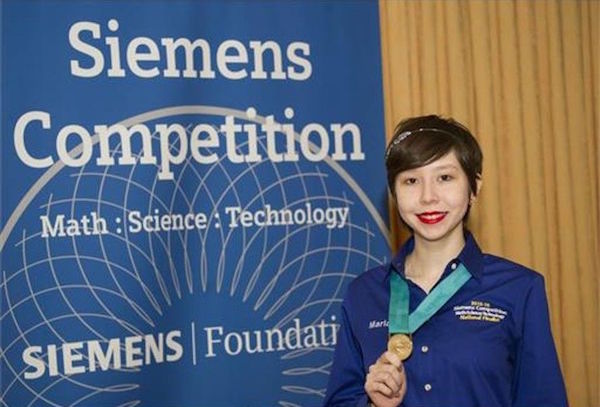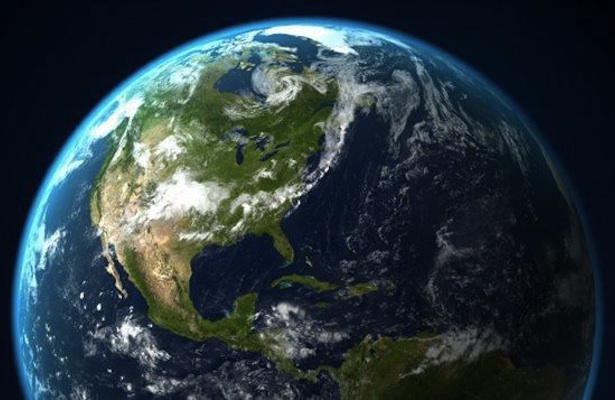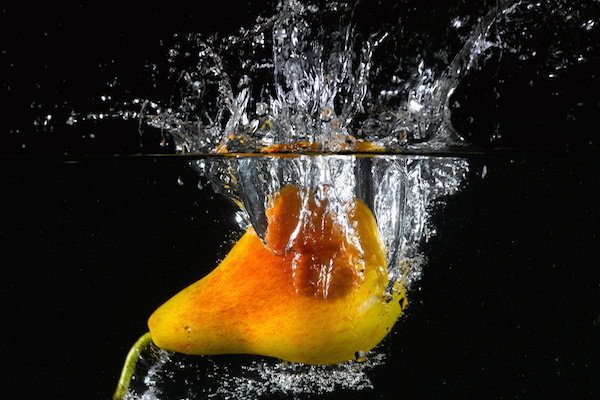A group of north coast women have put their bodies on the line, literally, in an effort to stop councils and government authorities spraying glyphosate in their weed reduction activities. Glyphosate, which was invented and is widely marketed by multinational chemical company Monsanto under the name Roundup, was named a ‘probable carcinogen’ by the World Health Organisation in March this year. This action, together with the forthcoming trial of Monsanto at the International Court of Justice next year has prompted the women to take a stand. With ‘I am water’ written on their bodies, the women are bringing attention to the protection of the essential resource from ongoing pollution with herbicides in the region. ‘Our bodies are made of water and we are one and the same as the environment. If we pollute the water with pesticides, we pollute ourselves,’ said Nadia de Sousa Pietramale, local bush regenerator and coordinator of Byron Shire Chemical Free Landcare. ‘While Monsanto will go on trial for crimes against humanity and nature, in Byron shire, glyphosate, a product developed by the company and an active ingredient of many herbicides, is still being poured into the environment where it ends up in our local rivers […]
Continue reading... →Lots of us have had a moment—a revelation, observation, or interaction—when climate change became more than a concept. What’s yours? By Liz Pleasant The other night, I was sitting in bed scrolling through Twitter when I saw the headline: “Report: Global temperature hike already halfway to ‘two degree warming’ limit.” I clicked it. The writer of the article, Brandon Miller, explained why many scientists agree that two degrees of warming is the cutoff point for “controllable” climate change, and how new reports show we’re already halfway there. On top of that, we just experienced the warmest October since observations began in 1879, and October was the sixth consecutive month to break a global temperature record. Seven of the 10 warmest months ever recorded happened in 2015. Talking about climate change isn’t new for me. I work at YES! Magazine, where we cover climate issues all the time. I read pitches on sea-level rise and sort through headlines on droughts, storms, and a fragile food system pretty much every day. But for some reason, this report really stuck with me. It scared me. I was still thinking about it the next morning while discussing coverage of the Paris climate talks with other […]
Continue reading... →17-year old Maria Elena Grimmett won the prestigious Siemens Competition in Math and Science for developing a new water purification method that can remove pharmaceutical pollutants from water. Maria Elena Grimmett was 11 when she noticed that her family’s well water was tinged brown, and she wondered why. Her curiosity sparked a six-year investigation into a new way to solve a common water pollution problem, and on Tuesday, that inquiry — conducted largely at Grimmett’s dining room table — won her a prestigious prize for young researchers and a $100,000 college scholarship. “Oh my goodness. I can’t tell you how shocked I was,” Grimmett, now 17, said outside an auditorium at George Washington University, which hosted the final round of the 2015 Siemens Competition in Math, Science and Technology. Grimmett’s initial questions about the color of her family’s water led her to learn about pharmaceutical pollution in the Florida Everglades. She was disgusted, and she wanted to help solve the problem. “I couldn’t imagine how people were letting this happen,” she said. So she settled on figuring out a new way to remove sulfamethazine, a common veterinary antibiotic used in pigs and cows, from water. Sulfamethazine contamination is common in rural areas, she said, and is helping to create antibiotic-resistant bacteria […]
Continue reading... →We can eliminate the use of fossil fuels completely and quickly, if countries can just find the political will. In a few decades, the world could be powered by nothing but wind, water, and sunlight. That’s the conclusion of a new study released just before world leaders meeting in Paris to strike a climate deal. “These are basically plans showing it’s technically and economically feasible to change the energy infrastructure of all of these different countries,” says Mark Z. Jacobson, director of the Atmosphere/Energy Program at Stanford University, who worked with University of California colleagues to analyze energy roadmaps for 139 countries. The researchers crunched numbers to see how much energy each country would need by 2050—including electricity, transportation, heating and cooling, industry, and agriculture—and then calculated how renewable energy could cover those needs, where it could go, and how much it would cost. People who are trying to prevent this change would argue that it’s too expensive, or there’s just not enough power, or they try to say that it’s unreliable, that it will take too much land area or resources,” Jacobson says. “What this shows is that all these claims are mythical.” Renewable energy is already cheap and […]
Continue reading... →Climate change action can feel so overwhelming, especially when we hear news of natural disasters, politicians who don’t believe in global warming, and companies who keep putting their money into dirty energy. So you might conclude that your voice doesn’t really matter at all in the grand scheme of global climate action. Let me convince you otherwise. I recently met with legendary feminist Eva Cox and discussed why the global environmental movement is facing so many challenges. For her, the key issues were these: We’re too negative. Many environmental activists and organizations focus too strongly on the threats and issues associated with climate change, such as natural disasters and spiraling pollution. This negative information has the effect of scaring people off: they’d rather ignore the issue than address it because it just seems all too hard. Instead, activists need to show the community that climate action has positive effects that help everyone. This uplifting message is much more likely to make people want to do something, rather than just stick their head in the sand. We’re not connecting the dots. It’s easy to pretend that climate change exists in isolation, but in reality it is connected to politics, society, employment, […]
Continue reading... →–and the average American does that 17 times a year. Food waste is a staggering problem. In 2010, close to 133 billion pounds, or a little over $160 billion worth of food, wound up in U.S. landfills. Kai Olson-Sawyer, a senior research and policy analyst at GRACE Communications Foundation, an organization that highlights the relationship between food, water and energy resources explains, “The fact is that food waste is truly a waste to all humanity of every kind.” That’s because when you toss a rotten apple or a moldy container of leftovers, you’re not just throwing away the food, but all the resources that went into producing it. “It’s really important to understand where and how things are grown,” says Ruth Mathews, executive director of the Water Footprint Network, an organization founded in 2008 to advance sustainable water use. Water plays a major role in food production, and as a result, food waste translates to an enormous amount of water wastage. All foods have a water footprint, the direct and indirect water that goes into producing a certain food—although some footprints are larger than others. In general, meats tend to need the most water for production, primarily because of the amount of food […]
Continue reading... →Skip the big box stores this year and create your own holiday crafts like these DIY eco-friendly holiday decorating projects! I think it goes without saying that we love DIY holiday ornaments around here. Not only do we have the satisfaction of being crafty, but we also love the fact that our ornaments are made from eco-friendly and/or recycled materials. Plus, rather than spendings tons of money on ornaments at big box stores, you can easily make your own! Here are 14 DIY ornaments to get you inspired: 1. Make a Recycled Gift Tag and Ornament — Want to include an ornament with each handmade gift you make this year? Make an ornament that can also double as a gift tag! 2. Create an Adorable Scrabble Ornament — Last week I created this scrabble ornament over at Feel Good Style. Not only are they oh-so-cute, but they’re super easy to make as well. 3. Button Wreath Ornament — Do you have some vintage buttons in your craft stash? Put them to good use with this button wreath ornament tutorial! 4. Upcycle Unused CDs into Mosaic-Style Ornaments — As the iPod generation, we’re all bound to have some unused CDs. Give them new life by […]
Continue reading... →Nina Gualinga is a force to be reckoned with. From the impending devastation of climate change, several activists have emerged who refuse to settle for the status quo. At only 22 years old, Nina Gualinga is one such activist. Born and raised in Sarayaku – an indigenous community of the Kichwa tribe nestled deep within the Ecuadorian Amazon – Nina’s powerful voice is backed by a chorus of indigenous resistance to protect the Amazon, the way of life in Sarayaku, and to keep the world hopeful. Oil extraction from reserves beneath the Amazon is a constant threat that forces the Kichwa tribe to always be on guard. These oil companies insist that drilling for oil will relieve Sarayaku from poverty. Nina explains that exploiting the land will, instead, threaten their way of life and impoverish them further. Nina is the fierce fresh face of eco-feminism – a movement defined by the connection between the domination of the environment and the exploitation of women, particularly in third world communities. And partnered with Amazon Watch, her strong campaign against the oil frontier expanding in the Amazon has attracted global attention. In 2012, the Sarayaku community won their fight for environmental and tribal […]
Continue reading... →








